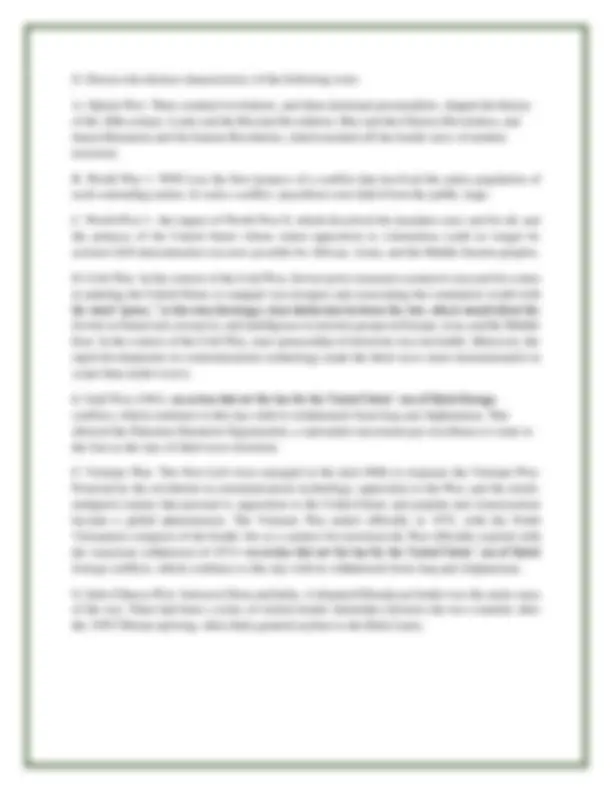



Study with the several resources on Docsity

Earn points by helping other students or get them with a premium plan


Prepare for your exams
Study with the several resources on Docsity

Earn points to download
Earn points by helping other students or get them with a premium plan
Community
Ask the community for help and clear up your study doubts
Discover the best universities in your country according to Docsity users
Free resources
Download our free guides on studying techniques, anxiety management strategies, and thesis advice from Docsity tutors
Identify historic wars which had taken place in the following regions in the world and devise /create your own matrix (Table) of categories to label them based on the concepts that we have discussed in Module 3 Lesson 1:
Typology: Study notes
1 / 2

This page cannot be seen from the preview
Don't miss anything!


Kathleen Joy S. Banzalan 1 - FS WAR AND TRANSNATIONAL TERRORISM ASSIGNMENT I. Identify historic wars which had taken place in the following regions in the world and devise /create your own matrix (Table) of categories to label them based on the concepts that we have discussed in Module 3 Lesson 1: A. Europe B. Asia C. North America European colonies, as well as a number of European ethnicities, particularly in the Balkans, felt that political independence was within reach. Their hopes were further strengthened by American President Woodrow Wilson’s stated support. An unanticipated result of the Vietnam War was the opening of the gates of immigration to Asians, who came in droves and brought with them the gurus and teachers who would found a generation of new religious movements whose roots sank deep into the United States and later in Europe and even the Soviet Union itself. The American counter-culture however ended badly. Experimentation with sex, drugs, and rock-and-roll burned out as the costs of indulgence over industry came due. Out of the morass came such phenomena as the American Jesus Movement and the Reagan Presidency. The Treaty transformed Europe into national states by breaking up the Austro-Hungarian Empire, while the Mandates that followed were created on the assumption that, in time, self- determination would occur. Southeast asia has long confronted violent extremism and continues to do so in indonesia. If social change could not produce happiness and inner peace, certainly religion could, and the newly religious appeared throughout the world. The Moral Majority led by Pastor Jerry Falwell brought fundamentalism into the American body politic for the first time since their Pyrrhic victory in the 1928 Scopes trial. A. Europe B. Asia C. North America
II. Discuss the distinct characteristics of the following wars: A. Opium War- Three seminal revolutions, and three dominant personalities, shaped the history of the 20th century: Lenin and the Russian Revolution, Mao and the Chinese Revolution, and Imam Khomeini and the Iranian Revolution, which touched off the fourth wave of modern terrorism. B. World War 1- WWI was the first instance of a conflict that involved the entire population of each contending nation. In such a conflict, anarchism soon faded from the public stage. C. World War 2 - the impact of World War II, which dissolved the mandates once and for all, and the primacy of the United States whose stated opposition to colonialism could no longer be resisted. Self-determination was now possible for African, Asian, and the Middle Eastern peoples. D. Cold War- In the context of the Cold War, Soviet active measures seemed to succeed for a time in painting the United States as rampant war mongers and associating the communist world with the word “peace,” in this way drawing a clear distinction between the two, which would allow the Soviets to funnel aid, resources, and intelligence to terrorist groups in Europe, Asia, and the Middle East. In the context of the Cold War, state sponsorship of terrorism was inevitable. Moreover, the rapid developments in communications technology made the third wave more internationalist in scope than earlier waves. E. Gulf War (1991)- an action that set the bar for the United States’ run of failed foreign conflicts, which continues to this day with its withdrawals from Iraq and Afghanistan. This allowed the Palestine liberation Organization, a nationalist movement par excellance to come to the fore as the face of third wave terrorism. F. Vietnam War- The New Left wave emerged in the mid-1960s in response the Vietnam War. Powered by the revolution in communications technology, opposition to the War, and the much- maligned country that pursued it, opposition to the United States and popular anti-Americanism became a global phenomenon. The Vietnam War ended officially in 1975, with the North Vietnamese conquest of the South, but as a catalyst for terrorism the War officially expired with the American withdrawal of 1973—an action that set the bar for the United States’ run of failed foreign conflicts, which continues to this day with its withdrawals from Iraq and Afghanistan. G. Indo-Chinese War- between China and India. A disputed Himalayan border was the main cause of the war. There had been a series of violent border skirmishes between the two countries after the 1959 Tibetan uprising, when India granted asylum to the Dalai Lama.